Wednesday June 1, 2016
For: Smooth and strong drivetrain, infotainment tech, strong value.
Against: Some hard interior plastics, no third seating row.
Score: 4.3/5
By Richard Bosselman
TAKE a ute, give it a boot, turn it into a station wagon: Once this was how every boat or caravan-hauling off-roader for the family was created and now, of course, we’re back to putting those old ways to good use.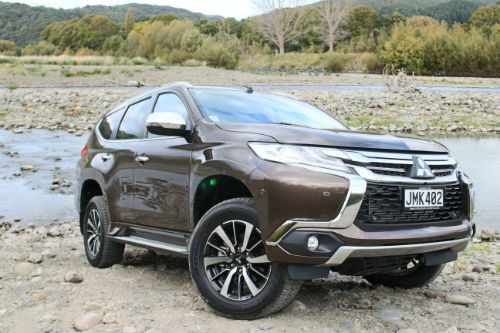
It’s an interesting forward step in a reverse direction. It’s potentially debatable whether the Ford Everest, Toyota Fortuner, Holden Colorado Seven, Isuzu M-UX and today’s subject, the Mitsubishi Pajero Sport, are as dynamically polished as those SUVs that are built as roadcars are. You know, without chassis rails, for starters.
But that’s fine: Some buyers are happy to trade off totally car-like for for trad truck toughness – and that’s where all these new ‘old school’ types excel: They’ll haul big loads and are very well-sorted for going places were soft-roaders shouldn’t tread.
Mitsubishi has been down this trail before with the Challenger, which was basically the same thing that the Pajero Sport is now: A rejigged, covered-in Triton. Yet whereas Challenger never really challenged, its replacement looks far better positioned, not least in the top-line $63,990 VRX edition featured today.
It would have been great to have had this edition on hand when the $78,990 Fortuner Limited and the $87,990 Everest Titanium were dual-tested back in February of this year.
The Pajero Sport is clearly a threat, even though it’s not quite the same, in that, unlike everything else, it has yet to front in seven seat format; for now, five chairs and a big boot is the format.
Our Fortuner-Everest fight was pretty even: The Ford took points for having more tech, a stronger attention to detail, superior ergonomic consideration and styling and having permanent four-wheel-drive. On the other hand, the Toyota seemed better value for the probable usage: Basically, we reasoned, why buy a chainsaw if all you need is an axe?
Ironically, we couldn’t help thinking that very same argument now plays for Pajero Sport, which is substantially cheaper still.
Style, specification
Even if it wasn’t quite so chrome intensive, Mitsubishi’s latest Dynamic Shield design language would still gather plenty of attention: There’s a lot of drama going on here, not least around the nose, which is very rakish with lots of shiny bits. You’d think whoever shaped this spends time drawing Klingon attack ships in his or her spare time.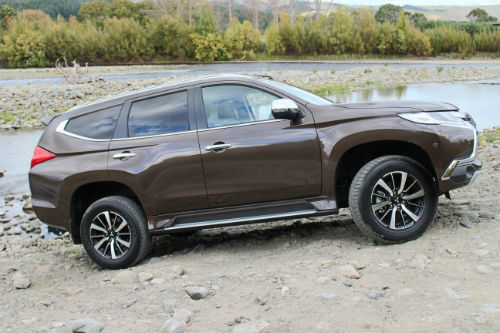
Some of the detailing is very extravagant. Consider the leading edge of the wheelarch panel where it envelops the headlight; that’s straight from a concept dream lap. It’s like a spear tip and must have been a headache to render in metal. Most makers would have, quite literally, sent their designers back to the drawing board to come up with something less demanding.
But from all angles, this is a good-looking truck, with more coherent styling than the ute, though it also suffers the same issue of looking a touch too narrow for its height. That, in turn, means it has a less assertive stance than its recently arrived rivals. Still, there’s something about it that is different and daring. That reaches to the colour palette; there would be very few vehicles I can think of that could carry the test machine’s metallic bronze-brown, but it was a hue that really worked here.
Anyway, as well as being a very striking design it also convoys a sense of sophistication and quality, something you wouldn’t expect given that it’s the ‘budget’ offer in this category.
Yet maybe Mitsi has slimmer profit margins than some others, because there’s nothing to visually suggest this is the cheapest offer in this select field; in fact, that glammed grinning grille, sculpted side profile with matt silver running boards, chrome side mirrors, silver roof rails, upswept and tinted rear windows, premium 18-inch alloys, LED lamps and impressively vertical tail-light stacks speak anything but poverty-pack.
That impression hardly lessens when climbing inside: The general ambience is Triton familiar, and it still feels narrow for its height, yet the fitout is definitely plush, with more soft-touch materials than you’ll find in the ute to distract to from the same hard-wearing plastics that pervade the donor.
At VRX level it is surprisingly premium. You don’t access the same level of snazzy driver assists as the Ford by any means, yet overall the ambience is good enough to warrant comparison with the Ford and Toyota – so too the kit content, which is comprehensive enough to embarrass the Fortuner in particular.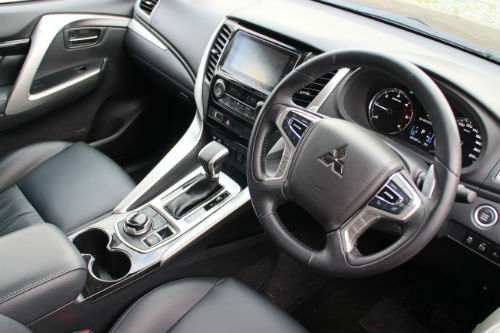
It’s possibly easier to mention what doesn’t arrive than what does. Keyless entry and start, daytime running lights, climate control, cruise control, rear parking sensors and Mitsubishi’s new Smartphone Link Display Audio system that includes Apple CarPlay and Android Auto and is controlled via a 7-inch touchscreen is standard fare. The VRX adds in leather upholstery, electrically adjustable and heated front seats, a premium eight speaker set up, dual zone climate control, a reversing camera, forward collision mitigation, blind spot warning, an ultrasonic mis-acceleration prevention system, automatic headlights and rain sensing wipers plus shift paddles on the steering wheel.
That’s a lot to help sell this model. What won’t is perhaps self-evident. Statistics suggest seven seat SUVs are very clearly preferred by a significant proportion of buyers and, on that count, the Sport comes up two pews short of the perfect picnic.
Conceivably, it has the space to take a third row, though Mitsubishi will presumably have to rethink how the side-mounted head airbags would work, because at the moment these don’t extend past the second row.
Power, performance
The Pajero Sport uplifts the Triton’s 135kW/437Nm 2.4-litre diesel four-cylinder, which is neither the most powerful nor the most refined in the category. It’s a vocal unit that requires working to get the best out of it.
At least, that’s how it presents in an automatic Triton ute. It seems a cruel juxtaposition that the Triton provisions an auto that, with five forward gears, is behind the pace within the ute category whereas the Pajero Sport comes along with an eight-stage unit that, being a first for this kind of wagon, has potential to immediately set a new standard.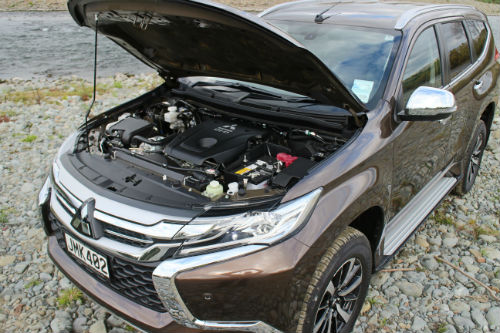
Certainly, those extra cogs should not be sneered at: This powertrain simply seems to be smoother, more involving and better attuned to driver intention with this latest transmission. Basically, a lot of the rough spots are removed; the power delivery is more fluent and relaxed, as reflected by it showing just 1700rpm on the dial when cruising at 100kmh on the open road.
That kind of performance is good for eking out decent economy – Mitsi quotes 8.5 litres per 100km, but it’s easily possible to see it hit a lower average in easy open road running - but it actually isn’t quite what the engine requires. Consider, notably, that peak torque doesn’t occur until 2500rpm, which is relatively high for a diesel – to get into the meat of that action requires having to pull it down a cog or two, which in turn increases the fuel burn, and the engine noise.
Even so, the engine is rarely caught out and the transmission, due to slick and schmoozy nature, generally minimises any under-bonnet lapses, noise and delivery-wise, so all in all in it’s a hugely pleasing plus feature for a vehicle that would also presumably draw interest through the provision of another segment-unique feature, the Super Select 4WD II system.
Four-wheel-drives that are actually all-wheel-drive all the of the time are a great thing, especially for those who adventure trek only occasionally. There’s never an issue of ‘should I, shouldn’t I’ about Mitsi’s system, which provides ability to drive on high-grip surfaces in high-range four-wheel-drive mode without trashing the transmission. There are also four driving modes - gravel, mud/snow, sand and rock – tailoring toward more specialized operation, all accessed via a rotating dial on the centre console, plus an electronic locking rear differential – always a good ‘last resort’ when the wheels start churning uselessly - and a hill descent control.
That’s a comprehensive fitout that will doubtless offer a lot of reassurance to owners who might tend to only venture off seal occasionally or will need to make prudent use of the all-wheel traction when towing.
Driving
Extra metal, extra glass, extra ... well, everything, comes with a consequence. At around two tonnes, the Pajero Sport carries a comfortably higher kilo count than the Triton and this does reveal in the manner in which it drives.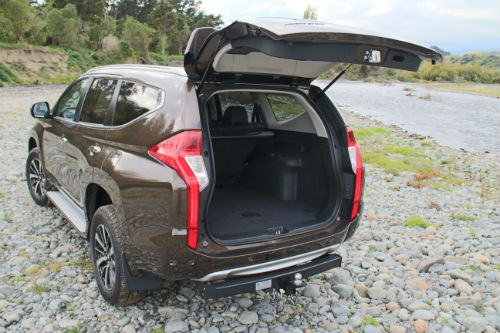
You’re always more aware of its mass; on gravel, for instance, where the ute feels almost nimble, the wagon requires a more thoughtful approach. It’s not a nervious type, yet oversteer and understeer always seem a little closer to hand, although when they evidence there’s an electronic aid to keep the vehicle in line. Perhaps that stability control is a little too over-zealous, in hindsight. The moment the tail flicks, the throttle dulls and the inside rear wheel self-brakes, which is a touch annoying.
Swapping out leaf springs for coils: It’s the standard play for all ute-derived wagons and Mitsubishi is no different in this basic revision, implemented of course in the hope that there will be a more positive outcome for ride refinement.
Sure enough, the coils – and, undoubtedly, the extra body weight above the rear wheel set – does make for a smoother ride. For a truck. If you’re more used to a monococque SUV, like a Hyundai Santa Fe, then the Pajero’s heavy-duty origins will still seem unmistakable. There’s less chop over uneven surfaces that occurs with a ute, but tendency towards fore-aft pitching on imperfect surfaces is still evident.
A relatively handy 11.4m turning circle and reasonably good visibility – apart from the restrictions imposed on the rear three-quarter view by the small, tapering rearmost side windows – are factors that play positively for urban use, less so the steering, which still feels slower than necessary.
The Pajero Sport seems a bit physically smaller (or at least, less visually imposing) than its rivals, and feels a little narrow across the cabin compared with its competition – as does the Triton come to think – yet for all that the cabin still copes pretty well with as many as five adult passengers, including where legroom and headroom are concerned.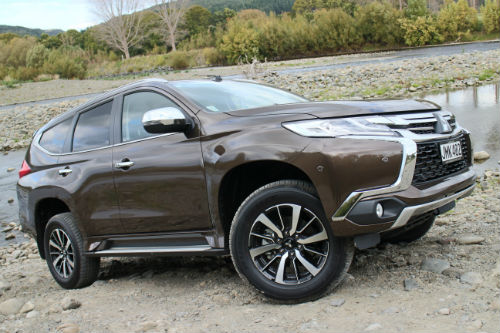
The latter is a pleasant surprise, really, because an elevated bench seat tends to be an unavoidable compromise with all these truck-based wagons because of the suspension and floor design. Yet even though some taller passengers’ heads will come closer to the roof lining than they might in a car-based SUV, we thought it had more rear seat legroom than the Fortuner in particular.
The driving position is pure Triton, too, but Pajero Sport seems to get a more comfortable front chair and the reach adjustment on the steering column is a good score.
Not having that third row might compromise when you’re asked to run young Timmy’s team-mates to soccer practice, but you benefit from having pretty good boot space.
Manufacturer maths suggest the positive of a 673-litre load area behind the rear seats doesn’t carry through to providing it class-best capacity when the rear chairs are folded down, when the cited total 1606-litre capacity quoted beats the Fortuner, on 1080, but falls below Everest (on 2010). However, from using your eyes rather than a measuring tape, it presents a very positive ‘load em up’ picture.
Like Triton the Pajero Sport does, however, lose points for having fewer interior storage options up front than some rivals. The door bins, a large bin under the central armrest and a decent glovebox are all good, but there aren’t many handy slots and flat spots for holding keys, sunglasses, your wallet, mobile and other paraphernalia.
In respect to the phone, though, once it’s paired into that infotaiment system then you might as well just tuck it into your trouser pocket, because thanks to the Link Display and, because I’m an Apple device user, the CarPlay, the setup is simply superb. Everything replicated on your phone comes up on the screen and the operational actions from thereon are a breeze. The sooner the latter becomes standard to all vehicles the better: Like I say, the touch prompts are logical, the displays coherent and all in all, once operating, there’s minimal distraction while on the move.
Verdict
The lack of a third row of seats will present a roadblock to some families, and maybe Mitsubishi’s styling isn’t for everyone, but beyond that the Pajero Sport has a lot going for it.
An excellent 3100kg maximum capability and always being in all-wheel-drive is a massive plus point for towing alone; obviously that Super Select system also abets confidence when off-roading, too. On top of this, while the cabin seems a little on the cosy side, it actually seats five adults in comfort and you cannot quibble about the specification: This is one very generously-equipped machine.
It’s probably just as well the Pajero Sport wasn’t directly compared with the Fortuner and Everest. In respect to pure value, it’s abundantly clear that that model that costs the least offers the most.


